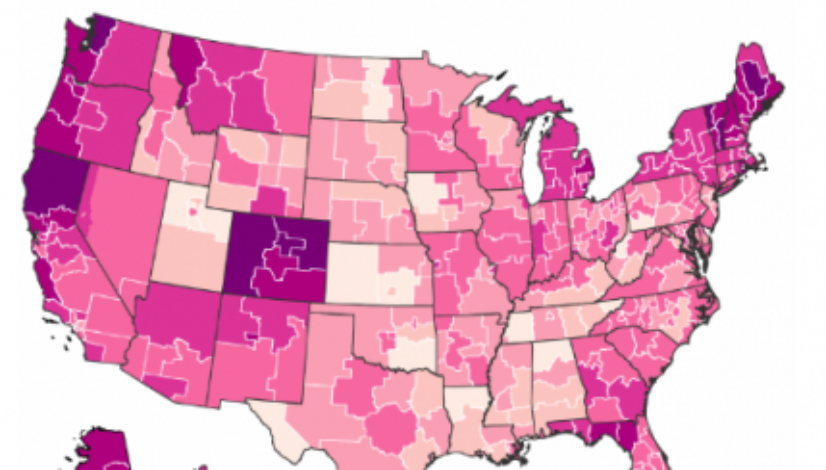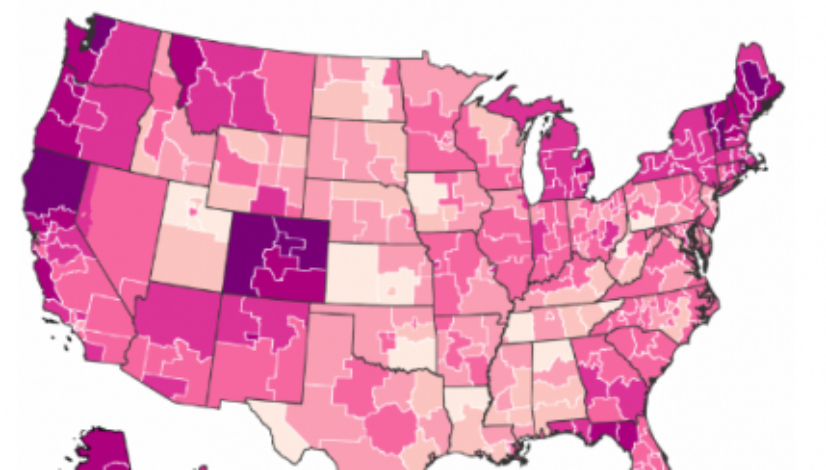Stop what you’re doing: This map shows how many people are getting high near you


Over 15 percent of San Francisco residents age 12 and over use marijuana monthly or more, the highest rate in the country. By contrast, the lowest use rates are in the far south of Texas, where fewer than 4 percent use monthly.
The report finds that nationally, 7.7 percent of people 12 an older — roughly 20.3 million Americans — use marijuana monthly or more. Broadly speaking, marijuana use rates are highest in the Western states and lowest in the South.
“We continue to see relatively wide variation in marijuana use” at the substate level, said Art Hughes, a SAMHSA statistician and a lead author on the report, in an interview. Overall marijuana usage rates are up by less than 1 percentage point since the period from 2010 to 2012, when SAMHSA last looked at these numbers.
Marijuana use rates have become a hot topic since Colorado first opened up its legal marijuana market in 2014, with several other states following suit. But since this data mostly covers the period before 2014, SAMHSA’s Hughes says you can’t really see many of the effects of legalization here.
Marijuana use in Colorado is relatively high, but it’s been that way for quite a while. “There are some states where we see rates on the high end even before legalization,” Hughes said.
The map above does illustrate the effect that marijuana policymaking can have on use. Different states have had radically different marijuana policies in place for years now, evident in the sometimes stark differences in use rates on either side of a state border.
Look again at the high use rates in Colorado — where marijuana has been decriminalized for some time and medical marijuana has been available for years — compared to the rock-bottom usage across the state line in Kansas.
Other important marijuana studies
Teen pot use: No, Colorado teen marijuana use isn’t spiking in legal era, 2015 survey shows
Mile high ranking: Where does Colorado rank among U.S. in its consumption of booze, drugs?
By the numbers: Marijuana use by U.S. adults doubles in decade, federal surveys show
Weed news and interviews: Get podcasts of The Cannabist Show.
Subscribe to our newsletter here.
Watch The Cannabist Show.
Peruse our Cannabist-themed merchandise (T’s, hats, hoodies) at Cannabist Shop.
One thing that the survey does point out is a potential, if unsurprising, link between attitudes on marijuana and rates of marijuana use. Across the board, people who use marijuana less are more likely to say that marijuana use is harmful. Conversely, those who use it more are less likely to say that use is harmful.
The most relaxed attitudes toward marijuana use were found right here in the District of Columbia, in wealthy Ward 3, where the average household income is $253,000 a year. Only 14 percent of Ward 3 residents said there was “great risk of harm” from smoking marijuana monthly. Roughly 1 in 10 Ward 3 residents said they smoked marijuana that often.
By contrast, nearly 50 percent of people living in Miami-Dade county in Florida saw a great risk of harm in regular marijuana use. Roughly 5 percent of Miami-Dade residents smoke monthly.
Of course, the causality here could go either way: People with lax attitudes about the risks of marijuana use may be more likely to use it. Or, people living in areas where many of their peers smoke weed may have a adopt more relaxed attitudes toward the drug.
Some researchers are starting to question the link between attitudes about marijuana’s harmfulness and rates of use of the drug. For instance, federal surveys have shown that fewer and fewer high school students say there’s a great risk of harm in using marijuana. And yet, marijuana use rates among that group have also fallen over the same period.
This story was first published on WashingtonPost.com
Topics: California, Colorado, marijuana use, medical marijuana, recreational marijuana, samhsa, san francisco, Texas




